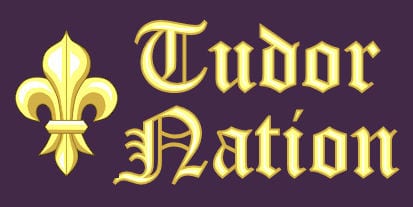Divorced, beheaded, died; Divorced beheaded survived
The fate of Henry VIII’s six wives
Henry VIII was King of England, Ireland and Wales from 1509 to 1547, during his reign he married six times. Two wives were divorced, two executed, one died and one out-lived Henry. But why did he have so many wives? This article will examine the political and personal reasons that influenced Henry VIII’s marital choices throughout his 38 year reign.
First Wife – Catherine of Aragon
Married for 23 years, 11 months and 2 days – divorced
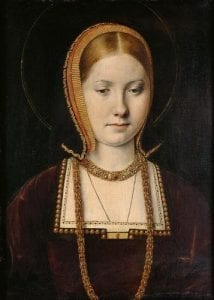
Catherine of Aragon was the daughter of Ferdinand of Aragon and Isabella of Castile. In November 1501 she had married Arthur Tudor, Henry’s elder brother and heir to the throne. However, the marriage was short-lived, Arthur became ill and died in the Spring of 1502. As the marriage had lasted such a short time, Catherine’s father refused to pay the second installment of her dowry unless Catherine married Prince Henry, now heir to the throne. King Henry VII was reluctant to allow the marriage to go ahead but refused to send Catherine back to Spain because he did not want to lose her dowry.
An Act of Chivalry
During the seven years that Catherine had been a widow, she and Henry had become close. They shared an interest in music and dancing and although Catherine was six years older, they were mutually attracted to each other. Henry also considered himself a chivalrous knight and may have viewed marrying Catherine as rescuing a damsel in distress. Henry had also spent his entire life doing as his father wanted, and having been forced to repudiate his betrothal to Catherine in 1505, now married the woman of his choice.
The early years of their marriage were happy and Catherine, a Spanish Princess, made a perfect Queen. She had grown up in the Spanish court and from the time of her betrothal to Arthur as a child, she had been raised to be Queen of England. Henry trusted her completely and made her regent when he went to France at the head of an army in 1513.
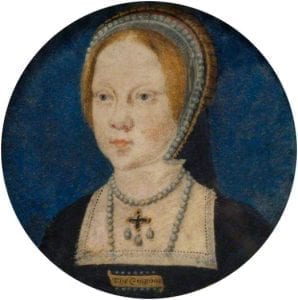
No Male Heir
The marriage of King Henry VIII and Catherine of Aragon was perfect in all respects bar one. The Tudor dynasty had been founded by Henry’s father and it was vital that Henry had a son to continue the Tudor line. Catherine had been delivered of a son, Prince Henry, on 1st January 1511, but he lived just six weeks. By 1518, despite six pregnancies, their only surviving child was Princess Mary, born 18th February 1516. Repeated pregnancies and the emotional upset of losing five of them took its toll on Catherine’s health. By 1524 it was clear that there would be no more children.
Punishment from God
King Henry VIII was deeply religious. Growing up as second son, it is likely that he was destined for a career in the church. In 1521 he had been given the title Fidei Defensor by the Pope for his defence of the Catholic faith and denouncement of Martin Luther. Henry had fathered a son by his mistress Bessie Blount in 1519 and he began to question why God had not blessed his marriage to Catherine with sons. He found two passages in the Bible which indicated that God was punishing him for marrying his brother’s wife: Leviticus 18:16 “Thou shalt not uncover the nakedness of thy brother’s wife: it is thy brother’s nakedness.” and Leviticus 20:21 “If a man shall take his brother’s wife, it is an unclean thing…they shall be childless.”
Attraction
By 1527, Catherine was 39 years old and had lost her youthful looks and trim figure. Henry had become infatuated with Anne Boleyn, the daughter of Thomas Boleyn. But Anne refused to surrender her virginity to Henry unless they were married. Her refusal simply made Henry desire her even more and he determined to marry Anne Boleyn.
The Reformation
It is likely that Henry expected Catherine to understand his need for a male heir and either agree to a divorce or to enter a convent. Her refusal and the Pope’s procrastination led to the English Reformation which broke with Rome and made the monarch the Head of the Church in England. A meeting of Convocation declared the marriage of Henry VIII and Catherine of Aragon null and void on 1st April 1533.
Second Wife – Anne Boleyn
Married for 3 years, 3 months and 23 days – beheaded
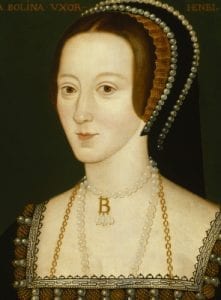
Anne Boleyn was the daughter of Thomas Boleyn and Elizabeth Howard and the niece of Thomas Howard, Duke of Norfolk. She had spent time at the court of Margaret, regent of the Netherlands and the French court before returning to England in 1522 and joining the household of Catherine of Aragon.
Marriage at any cost?
Anne was not considered beautiful but she was very charismatic and her French style of dress and mannerisms set her apart from the English ladies at court. She first caught Henry’s eye around 1525 but refused to become his mistress. Henry VIII was so determined to marry Anne that he broke with Rome and created the Anglican Religion to enable him to marry her.
There were cracks in the relationship long before the marriage. Anne was frustrated by the length of time it was taking for the King to be free of his first marriage and was often moody and argumentative. Henry may have had doubts about marrying Anne but having gone to such lengths he did not want to lose face.
Still no son
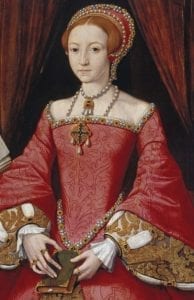
Henry secretly married Anne on 25th January 1533 after she announced that she was pregnant. There was no doubt in their minds that the child would be a boy. This was backed up by the court astrologers. However, when the child was born in September, it was a girl, Elizabeth. Henry cancelled all planned celebrations and blamed both Anne and God for denying him his prince.
Anne became pregnant three more times but each resulted in miscarriage. Some historians believe that Anne had Rhesus negative blood, a blood-type that causes mothers to miscarry second and subsequent babies with rhesus positive blood. This was unknown in Tudor times and Henry again looked to religion for answers. He believed that God was displeased with the marriage.
Henry’s personality change
In January 1536, Henry was taking part in a joust when he fell from his horse and was then crushed by the horse rolling on top of him. He was unconscious for two hours and it was believed that he would die. He survived but his personality had changed, he had become more ruthless and tyrannical. Doctors now believe that this was caused by damage to his frontal lobe. The fall also aggravated an old leg injury which caused him pain for the rest of his life.
God’s displeasure
Shortly after the event Anne miscarried for the third time. She blamed it on the stress of Henry’s fall and his interest in Jane Seymour, but Henry reasoned it was clear evidence that God was displeased with his marriage. He was also determined that he was not going to wait years to be rid of her. Thomas Cromwell began collecting evidence and on 2nd May 1536, Anne was accused of treason for committing adultery with five men including her brother George Boleyn. She was found guilty and executed by beheading on 19th May 1536.
Third Wife – Jane Seymour
Married for 1 year, 4 months and 24 days – died
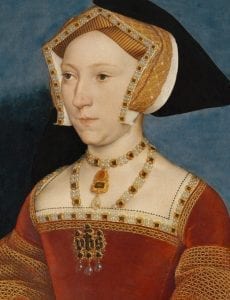
Jane Seymour was the daughter of John Seymour and Margery Wentworth. In 1533 Jane had become a member of Anne Boleyn’s household.
Opposites attract
Jane was everything that Anne Boleyn was not, she was unassuming, deferential, quietly spoken and demure. Henry first noticed her in the Autumn of 1535 and her family, eager for advancement, instructed Jane to encourage the King but to refuse to become his mistress. They were married eleven days after Anne Boleyn’s execution.
A son at last
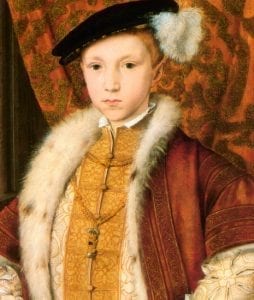
Henry had high hopes that Jane would give him the son he desired. Jane had six brothers so came from ‘good breeding stock’ and Henry was confident that God would be pleased with his choice of third wife.
Henry was a little concerned that Jane did not become pregnant immediately but was overjoyed when she announced her pregnancy in Spring 1537. Henry was very attentive to Jane and even sent abroad for quails eggs because Jane had a fancy for them.
After a very difficult labour lasting more than 48 hours, Jane gave Henry the son that he had desired for so long. He was named Edward and christened three days later.
Death of Jane
Sadly, Jane would not live to see her son grow up. On 16th October she became ill with diarrhoea and sickness, possibly caused by food poisoning since records indicate her eating ‘unsuitable foods’. Although she recovered she was taken ‘gravely ill’ on 24th October and died that night. The cause of her death is still debated by historians. Puerperal fever is unlikely to have been the cause since there are no records of her having a fever, similarly sepsis as a result of diarrhoea getting into a vaginal tear would have caused a fever. One possible explanation is that Jane developed thrombosis during her pregnancy and the clot travelled to her heart causing heart failure.
Henry was very upset by Jane’s death and shut himself away for several days. He also recorded his preference to be buried with Jane when his time came.
Fourth Wife – Anne of Cleves
Married for 6 months and 3 days – divorced
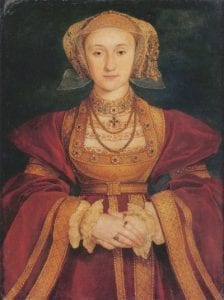
Anne of Cleves was the daughter of John Duke of Cleves and Maria of Julich Berg. She was not formally educated and could only speak, read and write in German. She had been taught needlework and the basics of running a household but was not given music or dancing lessons
Political necessity
Since the Break with Rome, England was politically isolated from much of Europe. Although he had little interest in marriage, Henry was persuaded by Thomas Cromwell that England needed a Protestant ally in Europe and that this could be brought about by Henry marrying a suitable Princess.
‘I like her not!’
After seeing Hans Holbein’s portrait of Anne of Cleves, Henry VIII agreed to the marriage going ahead. A contract was drawn up and preparations made. Anne arrived in England in late December 1539 and was escorted to Rochester. Eager to see his bride, Henry rode to Rochester from London armed with a New Year’s gift and entered her rooms in disguise. He was bitterly offended when she showed little interest in his ‘gift from the king’. Prior to her arrival in England Anne had been told much about her future husband and country, but she had not been told of Henry’s passion for masques and disguisings. Henry removed his disguise and was then introduced to Anne, but the damage had been done and after the meeting Henry declared ‘I like her not’ citing her strong features, German accent and mannerisms.
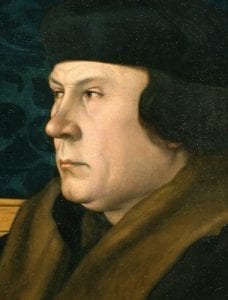
Back in London, Henry VIII immediately instructed Thomas Cromwell to find him a way out of the marriage. But the contract had been thoroughly negotiated and to not proceed risked a war with Germany that England could not afford.
The marriage went ahead on 6th January 1540 but Henry found he was unable to consummate the marriage. Records suggest that the 49 year old King may suffered from impotence and blamed Anne rather than admit the condition. Some historians have also indicated that Anne may not have been a virgin and that Henry had been repelled by discovering this fact. The fact that Hans Holbein was not punished for his painting of Anne of Cleves suggests that the portrait was a reasonable likeness.
Another divorce
Kathryn Howard, the 19 year old, attractive niece of Thomas Howard, Duke of Norfolk, had been appointed lady in waiting to Anne of Cleves. Henry was very attracted to her and decided to divorce Anne and marry Kathryn.
Anne’s marriage to Henry VIII was annulled on the grounds of a pre-contract with Francis, Duke of Lorraine and non-consummation. Anne did not contest the divorce and was granted the title King’s sister. She was given precedence over all ladies of the court save the Queen and the King’s daughters. She also received a very generous divorce settlement of property with an income of £3000 per year including Anne Boleyn’s childhood home, Hever Castle.
Anne of Cleves outlived Henry and died 16th July 1557.
Fifth Wife – Kathryn Howard
Married for 1 year, 6 months and 16 days – beheaded
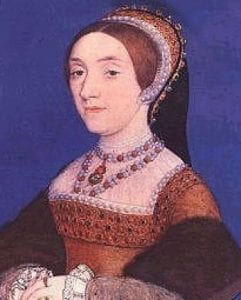 Kathryn Howard was the daughter of Edmund Howard and Jocasta Culpeper. She was also the niece of Thomas Howard, Duke of Norfolk. After the death of her mother, Kathryn had been raised in the household of her grandmother, the dowager Duchess of Norfolk, Agnes Howard.
Kathryn Howard was the daughter of Edmund Howard and Jocasta Culpeper. She was also the niece of Thomas Howard, Duke of Norfolk. After the death of her mother, Kathryn had been raised in the household of her grandmother, the dowager Duchess of Norfolk, Agnes Howard.
Pretty young lady
In 1539, Kathryn had been appointed lady-in-waiting to Anne of Cleves and once in post she quickly caught the eye of the king. Young, pretty, educated and fond of music and dancing she made Henry feel young again. He was soon smitten and determined to make her his fifth wife.
Catholic, conservative faction
The Howard family were part of the Conservative, Catholic faction at court and were eager to bring about the downfall of the reforming Protestant faction headed by the Seymour family. When Kathryn caught the eye of the King, Thomas Howard instructed his niece to encourage the king and seek preferment for her family.
Henry married Kathryn on 28th July 1540, three weeks after his marriage to Anne of Cleves was annulled. The couple embarked on a progress around England before returning to London. In the Spring of 1541, Henry’s ulcerated leg became infected. He did not want his young wife to see him looking ill and so refused to see her.
Kathryn’s past caught up
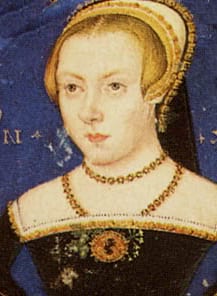
Kathryn enjoyed spending her time with the young people of the court and it was soon rumoured that she was committing adultery with Thomas Culpeper, Keeper of the King’s armour. When Henry recovered and the royal couple went on another progress, Kathryn and Culpeper continued to meet secretly aided by Jane Boleyn, widow of George Boleyn.
When Kathryn was living in the household the Dowager Duchess of Norfolk during her teenage years, her music teacher Henry Manox took more than a professional interest in Kathryn. It was later revealed that they had shared ‘intimate moments’. The Dowager Duchess’s secretary, Francis Dereham, also took an interest in Kathryn and visited her late at night in the girls’ dormitory.
In the Summer of 1541, Dereham sought an audience with Kathryn and demanded a good position at court in exchange for him keeping Kathryn’s past a secret. Dereham was duly appointed her private secretary and soon discovered the relationship between Kathryn and Culpeper. Dereham was very jealous and made no secret of the fact that when the king died he would marry Kathryn.
Around the same time, John Lascelles, whose sister Mary Hall had been a chambermaid in the household of the Dowager Duchess, told Archbishop of Canterbury, Thomas Cranmer, the story of Kathryn’s past. Cranmer duly passed the information to the King who ordered an investigation. Under questioning Dereham confirmed his previous relationship with the Queen and also implicated Thomas Culpeper.
A second execution
In early November Henry ordered Kathryn be confined to her quarters. He left Hampton Court soon afterwards and never saw Kathryn again. She was arrested on 12th November 1541 and stripped of her status as Queen. Dereham and Culpeper were executed in December 1541. Kathryn Howard was attainted by Act of Parliament in January 1542 and taken to the Tower of London. She was executed by beheading on 13th February 1542.
Sixth Wife – Katherine Parr
Married for 3 years, 6 months and 16 days – beheaded
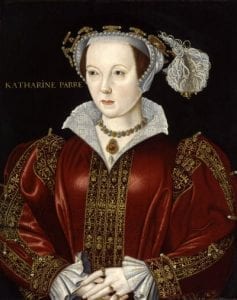
Katherine Parr was the daughter of Thomas Parr and Maud Green. At the age of 17 years she had married Edward Burgh and after he died she married John Neville, Baron Latimer. In 1543 the baron was dying and Katherine hoped to be able to marry Thomas Seymour, the man she loved.
Kind and gentle
After the death of Baron Latimer Kathryn had taken a position in the household of Henry VIII’s daughter, Lady Mary. It was here that Henry first met Katherine and it is likely that he was impressed by her kind and gentle manner. Now in his 50s, overweight, with a suppurating leg ulcer it is likely that Henry chose Katherine as a companion and nursemaid. Indeed, following their marriage on 12th July 1543, it was generally Katherine that changed Henry’s leg bandages.
Protestant reforming faction
Katherine wa a Protestant and believed that becoming the wife of Henry VIII was God’s will since she may be able to persuade the King to further reforms within the church. Despite the English Reformation and the establishment of the Anglican church, Henry had never become a Protestant. Kathryn frequently engaged the King in lively religious debate and persuaded Henry to allow her to publish ‘Prayers or Meditations’ – the first book published by a woman under her own name.
Katherine Parr also persuaded Henry to invite his three children to court and to allow her to oversee the education of Edward and Elizabeth. Protestant, Humanist tutors were hired for both children. Henry’s regard for Katherine was such that when he invaded France in 1544 Katherine was named regent in his absence.
The Catholic faction’s revenge
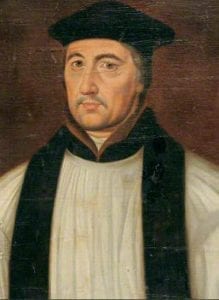
In the Spring of 1545, Henry’s health took a turn for the worse and he was again in considerable pain with his leg. With the King in bad humour, the Conservative Catholics headed by Stephen Gardiner, saw an opportunity to bring about Katherine’s downfall. They made sure that the King was aware of the spread of Lutherism throughout the country and as a result an order was made for heretics to be arrested and charged. One of those charged was Anne Askew.
Henry was informed that under questioning Anne Askew had mentioned the Queen’s name. He was also reminded that all the ladies close to the Queen were Protestants and that Katherine spent many hours discussing religion with him. Henry was persuaded to sign a warrant for Katherine’s arrest. However, it was dropped and discovered by one of Katherine’s household.
When she saw the warrant Katherine became very upset and hysterical. When Henry heard her cries and visited her to find out what was wrong. She told him that she was worried that she may have displeased him in some way. As soon as she was able, she made a point of explaining that she only discussed religion to distract Henry from the pain in his leg. When Wriothesley arrived to arrest Katherine, Henry dismissed him saying he was a fool.
Survived
By December 1546 it was clear that the King was dying. Katherine was summoned to say goodbye to her husband on 26th January 1547 and Henry VIII died two days later.
In May 1547 Katherine married Thomas Seymour and their daughter Mary was born in August 1548. However, Katherine contracted puerperal fever and died on 5th September 1548.
Published Aug 7, 2020 @ 8:50 pm – Updated –
Harvard Reference for this page:
Heather Y Wheeler. (2020). Why Did Henry VIII Have Six Wives? Available: https://www.tudornation.com/why-did-henry-viii-have-six-wives Last accessed [date]
